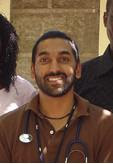When I received the records, the work-up was limited by the facilities and the therapy was driven by a shot-gun approach. Despite the “prettiness” of St. Camillus, their lab is not what I would have expected it to be. As internal medicine docs, tests are our friends and there were none at this hospital. They couldn’t even do blood cultures. When I was reviewing the records, there wasn’t much to go on, and St. Camillus did not have much more to offer, and so I had them discharged with the hope that there would be some way to diagnose the problem and possibly fix it.
Our next step was to proceed to St. Joseph’s hospital aka Ombo. This hospital has been here for a long time, since even before Matoso Clinic was even started. In fact, the first volunteers worked there for three months to get the feel of taking care of Kenyans before opening the clinic. These initial medical reports are fascinating from a historical perspective and they are all primary sources.
Well, I digress. We took them to the other hospital where I ordered a battery of tests, well, a battery of tests for them. In the end, I got about half of what I wanted. And we had to spend 8 hours at the hospital waiting for the lab techs to process them all. Wow. This is our referral hospital.
As expected, I was only able to narrow the differential diagnosis in these two patients. One had some issue with her gallbladder. Whether it was infected or not, she would need some sort of procedure or CAT scan to determine what to do next. The second one required a repeat ultrasound that we couldn’t get until this week. Regardless, they needed more detailed work-ups at the provincial hospitals – the referral hospitals for the province.
Now, the whole management of resources comes into play. The point of the RCAR program is to maximize the survival potential for the maximum number of kids, not to spend thousands of shillings on a few number of kids. As I was discussing the patients with the Lalmba medical director, we were trying some other therapies in the mean time trying to decide what the definitive course of action should be. Unfortunately, the patient with the gallbladder issue died a few days ago. We were having some issue with transportation and I was informed that she was not doing well. They were able to pick her up and bring her to the clinic. A brief evaluation revealed that she was dying. Thankfully, we were able to get her home so that she could die with her family. I learned that she died later that night.
The other one did get her ultrasound and it looks like she has lymphoma but needs a biopsy in order to confirm or discount this possibility.
The frustrating aspect of these cases is the lack of resources even at the so-called referral hospitals. They don’t even have full chemistries including bicarbonate, something that we use frequently to help determine the acid-base status of the patients. Part of the problem is the expense of automation. All these lab studies have to be processed by hand using special kits. And even then, they don’t necessarily get it right. Furthermore, it is much easier to manage patients when the resources of the patient are very limited. When a patient says, I cannot go to the hospital, then the options for us are fairly limited but straightforward. However, when we are spending thousands of shillings for further evaluation, it is difficult to know when to stop, when is such and such money too much money.
Well, I guess that is the nature of our work here. Sometimes you win some and sometimes you lose some. The wins feel really good and overall the work here is extremely gratifying, and the losses, well, one has to take them in stride. We can’t save the world, but we’ll keep trying one person at a time.



No comments:
Post a Comment